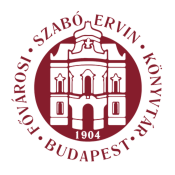Matits Ferenc: Protestant Churches - Our Budapest (Budapest, 2003)
was that of simplicity and economy. That was especially true for the interior. The plaster mouldings on the capitals were scrapped, as were the baldachin- topped pulpit and the altar superstructure complete with columns, tympanum and altarpiece. The ornamental pulpit, which used to be level with the gallery, was replaced with a simple portable lectern. A large cross was installed above the altar in the sanctuary. In the 1990s a circular window was cut in the wall behind the juncture of the cross, which was stained darker, together with the pews, the side galleries and the wooden balustrade of the oratory. Three rows of lights were sunk in the ceiling. In 1957-58 and then in 1969-71 external renovation of the church was also carried out. The pipes of the organ, whose construction began in i960 to plans by organ- player Zoltán Peskó, has come to occupy the entire length of the north wall by now. Besides funds raised by the congregation, significant donations were made by Finnish and Danish supporters to help build the monumental three-manual concert organ. His father’s work was concluded by György Peskó; it was to his designs that the organ, pushed somewhat forward, was completed in the late 1970s. Today the church often houses organ concerts. The red-marble baptismal font was placed on the right of the altar, while on the left is the pulpit. In the first half of the eighties, during the comprehensive reconstruction of the Castle District, the church in Bécsi kapu tér, as part of the architectural heritage of the country, was also renovated inside and outside. The mosaic representing the Holy Spirit as a dove, the work of mosaic-maker and painter András Rác, was removed from the church body to its present location above the interior gate of the main entrance, while the inscription A mighty fortress is our God appears above the external gate. After 1990, the German-language service of the Castle congregation became an independent organisation. Services are held by a pastor from Germany in the chapel formed from the congregation hall. The Lutheran Church in the Fasor No. 17-21 Városligeti fasor, District VII The assembly of the Lutheran church passed a decision in the year 1900 to acquire a 7,700-square-yard plot in the new residential quarter emerging between the City Park and the Great Boulevard, to build a new Lutheran secondary school and church. The construction of the Fasor Secondary School '7
